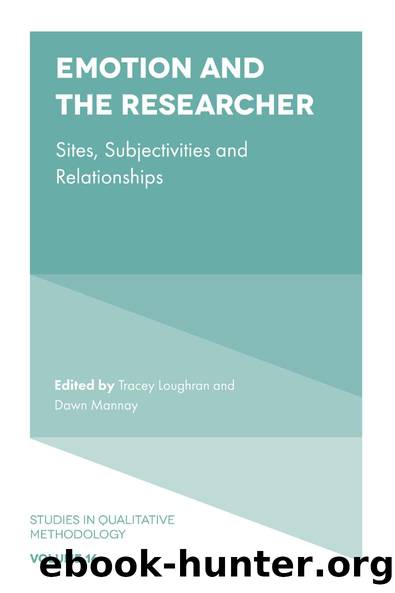Emotion and the Researcher by Unknown

Author:Unknown
Language: eng
Format: epub
ISBN: 9781567203646
Goodreads: 2259202
Publisher: Praeger
Published: 2000-07-30T00:00:00+00:00
INTERPRETING EMOTIONS
We have suggested that gaining âemotionally sensed knowledgeâ during the interview itself is not straightforward. These challenges crystallise when the researcher sits down with the transcripts, recordings and other data and begins to interpret. However, having time to reflect on what was said and unsaid and to separate words and bodily signals can also suggest new understandings or questions. As we have intimated, this is particularly challenging when working within another culture, or where the participantâs first language differs from that of the interviewer. We focus here on two important difficulties of interpretation. The first stems from how the emotions â fears, hopes and beliefs â of the interviewee influence their answers and the second is about the difficulties of identifying and understanding the intervieweeâs emotions.
A key concern in any research is understanding how the participantâs emotions may influence their answers. Making emotional sense of peopleâs stories also involves seeing the question from their perspective, including how much they want to disclose, whether they are willing to âopen themselves upâ and show their vulnerabilities, and whether they are saying what they think the researcher wants to hear. People may also refrain from raising experiences they judge will be of little significance to the researcher. The young Zambians often challenged why their lives would interest someone from the UK. Some in Swindon said they were ânot worthâ interviewing. In both places, we often had to assert that the âmundaneâ is interesting and the participantâs voice important and of significance to the research.
In Zambia, few of the young caregivers said they received help from family, friends or organisations with their caring responsibilities, despite visible evidence to the contrary. While this could partly have been a rapport issue, reflecting Carolineâs position as a possibly untrustworthy âoutsiderâ, it was also suggested to Caroline that this was done in the hope that she would support them and their families. While this might be thought simple âmisinformationâ for personal gain, its significance is far greater. It provides a glimpse of the precarious lives these young people lead, their hopes of ârescueâ and their difficulties in negotiating the complex systems of âdevelopmentâ research and aid.
The Swindon interviewees did not expect material help but did sometimes want social approval or reassurance. After reading the transcripts, looking at their personal community âmapsâ and ruminating on the âfeelâ of the encounter, we thought that their beliefs about how relationships with family members and friends âoughtâ to be sometimes affected what they told us. This might be by exaggerating the closeness of a bond or the frequency of contact, skating over tensions in a relationship or leaving out valuable information about a relationship. Again, such âmisinformationâ can provide information of another kind â here concerning beliefs about friendship and family â but we remain uncertain about how well we detected such influences. These uncertainties of interpretation relate to and question our ability to understand the emotional meaning of aspects of an interview like hesitancies, uneasiness, fervour and enthusiasm in our respondentsâ accounts.
Download
This site does not store any files on its server. We only index and link to content provided by other sites. Please contact the content providers to delete copyright contents if any and email us, we'll remove relevant links or contents immediately.
Rewire Your Anxious Brain by Catherine M. Pittman(17581)
Talking to Strangers by Malcolm Gladwell(11861)
The Art of Thinking Clearly by Rolf Dobelli(8836)
Mindhunter: Inside the FBI's Elite Serial Crime Unit by John E. Douglas & Mark Olshaker(7827)
Becoming Supernatural by Dr. Joe Dispenza(7099)
Change Your Questions, Change Your Life by Marilee Adams(6636)
Nudge - Improving Decisions about Health, Wealth, and Happiness by Thaler Sunstein(6629)
The Road Less Traveled by M. Scott Peck(6626)
The Lost Art of Listening by Michael P. Nichols(6462)
Enlightenment Now: The Case for Reason, Science, Humanism, and Progress by Steven Pinker(6402)
Win Bigly by Scott Adams(6306)
Mastermind: How to Think Like Sherlock Holmes by Maria Konnikova(6224)
The Way of Zen by Alan W. Watts(5787)
Daring Greatly by Brene Brown(5636)
Grit by Angela Duckworth(4728)
Big Magic: Creative Living Beyond Fear by Elizabeth Gilbert(4717)
Men In Love by Nancy Friday(4314)
Flow by Mihaly Csikszentmihalyi(4047)
The Four Tendencies by Gretchen Rubin(4017)
